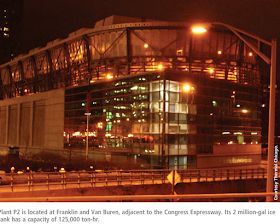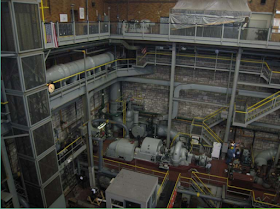In 1995, Commonwealth Edison started running a large ice making machine in the northeast quadrant of State and Adams Streets. The first floor IS standard retail outlets. But the remaining stories looked more like a parking garage. But instead of cars, those stories hold ice tanks, chillers and cooling towers. The chillers and cooling towers are industrialized versions of the unit you see outside homes and buildings that have central air conditioning. The chillers use an electric motor to drive a compressor and the cooling tower is like the coil and fan in the air conditioning unit. These chillers freeze the water in the ice tanks. They are run at night when normal demand is low. Back then, ComEd generated about 40% of its electricity with nuclear power, which was about twice the national average. Running the chillers at night helped maintain a load for the nuclear power plants. (
Enwave is the current owner of this chilled water utility.) During the day the plant does not run the chillers. Instead, the ice slowly melts so that it can supply 34-degree water to buildings in the loop. This chilled water is run through heat exchangers in the customers' buildings. The water comes back to the cooling plant at 54-degrees, melts some more ice, and repeats the cycle. [The information for this posting comes either from a
District Energy article or the Enwave web site.]
A satellite image shows the top of the building is three large cooling towers.
Since the Montreal Protocol on Substances that Deplete the Ozone Layer went into effect in September 1987, in the early 1990s building managers were faced with the expensive prospect of either replacing or refurbishing their chillers. ComEd offered a third choice --- replace them with relatively cheap heat exchangers and buy chilled water from them. Needless to say, the new chillers used in the "ice machine" were of a modern design that did not threaten the ozone layer. The heat exchangers in the customer's building occupied 90% less space than on-site chillers. Removing a lot of equipment from the building not only freed up valuable real estate, it reduced a lot of the operational and maintenance expense for cooling the building. ComEd started with about 12 customers for that first plant in 1995.
The equipment, lights and people in large office buildings generate more heat than they loose to the weather, even in the winter. So cooling a large office building is a year around expense. In the summer, the air conditioning equipment could consume half of the building's electric supply. So using ice water for cooling not only provided a load for the nuclear plants at night, it reduced the the peak demand during the day. Reducing the peak demand not only means fewer power plants are needed, it means the grid to supply the electricity can be smaller (cheaper). Furthermore, selling ice water was an unregulated business. Regulated utilities were looking for opportunities to diversify into unregulated businesses.
This business model was successful enough that they built their second plant the next year.
 |
Thermal Energy owned the business in 2012 when the District Energy article was written. Enwave now owns the plant.
Note that the zoning laws here did not require retail outlets on the first floor. |
P3 is inside the Blue Cross-Blue Shield of Illinois Tower. P4 is in the basement of the Merchandise Mart and uses river water instead of cooling towers to cool the chiller's working fluid. P5 does not have any ice tanks. All of these plants are interconnected with each other and the customer's building with a distribution network that has 8 trench miles. The size of the pipes vary between 12 and 30 inches. The different plants use different technologies and are interconnected so that the operators can choose which equipment to run based on availability of equipment, demand, and market conditions for electricity.
The details of the plants:
Plant P-1, State and AdamsStartup: May 1995
Current capacity: 20,000 tons, plus 66,000 ton-hr ice tank
Plant P-2, Franklin and Van BurenStartup: July 1996
Current capacity: 23,000 tons, plus 125,000 ton-hr ice tank
Plant P-3, 300 E. RandolphStartup: May 1997
Current capacity: 23,000 tons, plus 100,000 ton-hr ice tank
Plant P-4, Merchandise MartPurchased: June 1997
Current capacity: 20,000 tons, plus 24,000 ton-hr ice tank
Plant P-5, 300 N. Wabash BuildingStartup: June 2002
Current capacity startup and expansion: 15,000 tons
[EnwaveChicago-history]
Another advantage of district cooling is that it is shared by buildings that have different uses such as office, residential, retail, hotel, and computer server farms. When the peak usage of one type of service goes up, the usage by some of the other types of service will be off-peak. This means the peak capacity of a shared utility can be smaller than the sum of the peak capacities if every building had its own chilling equipment. This further reduces the number of power plants and the size of the grid needed to serve the loop.
Using ice water from the utility also frees up space on the roof for LEED points (Leadership in Engergy and Environmental Design [
Springfield]) such as solar panels and/or a "green" roof.
I read that the new Riverside Building (phto to the right) choose to use the district cooling solution.
But the University of Chicago's Cummins Life Science building choose to replace their 1,020-ton chillers and 4160V electrical feeds even though it was very challenging (i.e. expensive) to fit the new equipment in while the old equipment was still running. Not only did they want to prevent the occupants from sweating and keep the computers running, they did not want sensitive biological research projects to die. [
IDCS]
When I tried to track down a reference I forgot to include, I also found the following: "Chicago’s [district] is the largest contiguous system in the nation, if not the world, with fourteen miles of pipe and an eight million gallon capacity." [
SustainableChicago]



















































